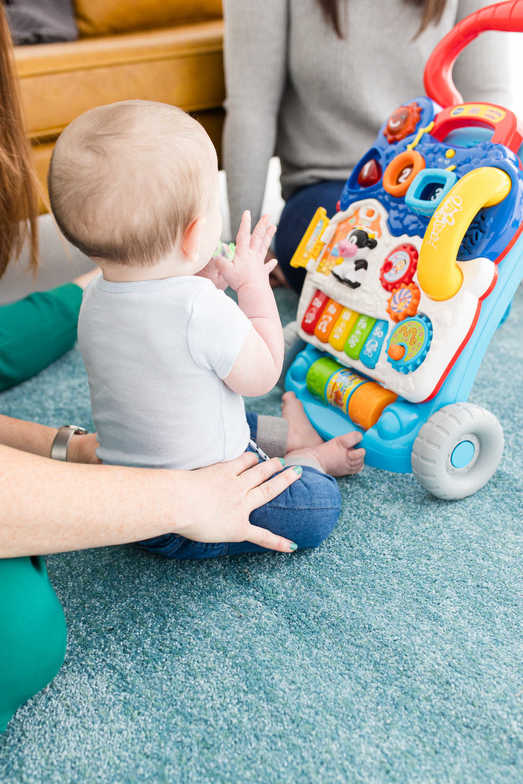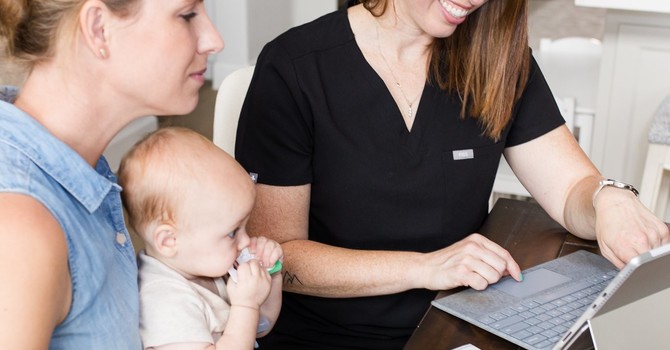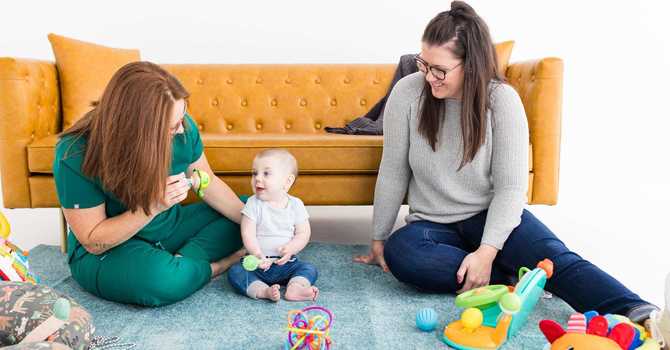
My goal with these checklists is to create a resource for parents, a resource that provides both the age-appropriate milestones AND purposeful play ideas on how to help your little one stay on track. There is so much information out there, sometimes information overload, and having this in one place I hope it makes your parenthood journey a little easier.
OK, so you’re reading this because your little one is 6-9 months old. It’s a fun time, isn’t it?! Those personalities are exploding and you’re starting to get into a groove. AND they are almost mobile! GAME CHANGER! Now is the time to babyproof the house if you have not already done so!
During this time those gross motor skills seem to explode, they can roll tummy to back and back to tummy and they can get from one side of the playmat to the other. Your little has likely figured out how to spin on their belly; this is called pivoting in prone AND it’s a pre-crawling skill. Get ready!
Playing on their tummy, backs, sides, and in supported sitting are ALL still very important. Here are some purposeful play ideas for kids who are 6-9 months old.
- Place toys just out of reach. You will see the most results if their fingertips can almost touch, if it is too far your kiddo will lose interest fast and move on.
- You can do this while playing on their backs, it will encourage rolling to the side and/or tummy. Don’t be afraid to practice rolling often - those abdominals with thank you later!
- If your kiddo is on their tummy (remember, active shoulders and elbows or hands in contact with the floor) move toys in a circle around your baby to encourage spinning on their belly. If you find your little one gets stuck, rock their hips back and forth and encourage them to reach across with one arm toward the toy to get moving again.
- Crawling with their belly on the floor may also emerge during this time! If your child is playing on their tummy, place a toy directly in front and out of reach. Watch them wiggle, kick, and reach to get there! Same thing here – if your little is stuck, rock their hips back and forth and encourage reaching toward the toy.
- Your kiddo’s sitting balance is likely improving. Here are some simple ways to encourage sitting balance for 6-9 months old:
- Sit with a boppy pillow or prop-a-pillar around their waist. Start with the pillow in front (and you sitting in back) and place their arms on the boppy or prop-a-pillar and engaging toys at eye level help gain an upright trunk and establish stability. Over time, move the boppy or prop-a-pillar to the back and encourage sitting without support from their arms. You can also use a lap desk, upside-down balance board, or elevated toy in front to facilitate sitting with support from arms.
- Learning to sit independently is important AND getting in and out of sitting independently may be more important. Practice side sitting at this age with the bottom arm supporting the body while the top arm plays. Side sitting is important because kids transition through this position on their way to crawling on hands and knees, without side sitting it is hard to start crawling from the sitting position. I like to use push toys and other inclined toys during this phase. They provide a wonderful play surface, encourage an upright trunk, and ideal head positioning during play (vs looking down at the ground with a rounded back).
- And don’t forget to encourage reaching in sitting, have your little reach for toys in all directions (left, right, forward, up, and slightly behind). This helps them develop balance and body awareness!
- You may see your child get onto the hands and knees during this time – woohoo! Kids usually get to this position using two different techniques.
- Pushing up with their arms and pulling in their legs from their tummy AND/OR
- From sitting, transitioning through side sitting.
Both are WONDERFUL! However, I highly encourage practice with both. From their tummy, gently lift their hips and watch them push up with their arms and engage their lower abdominal muscles to pull their legs inward. You can also try this method by cupping their shoulders with your hands and bringing them onto straight arms. From sitting, have your child sit next to your leg and place a toy on the other side of your leg. Watch them reach for a toy and rotate their body, be sure to help support their hips and legs because sometimes they get tangled!
Pro Tip: Once they are on hands and knees, cup their shoulders or legs, whichever seems to be the area of least control, and gently rock them back and forth. I find kids will maintain their interest in the position longer if they are rocking.
If you want to take it a step further, place that push toy in front of them and watch them reach and hold on to those hips to make things a little easier for them or have them positioned over your leg, hands on one side, knees on the other. This will help them gain necessary strength and coordination for crawling!
And if you want to encourage those transitions, when on hands and knees, bring one hip on the floor at an angle and watch them navigate their way to sitting! You can also use toys for this transition too, have them look in the opposite direction as the hip that you are moving and they’ll help you place that booty on the floor. Nice work!
- Don’t forget, play on their backs during this time is also very important. It is important for continued abdominal and neck muscle strength. Place toys on their feet and have them reach to take them off. If your little one struggles with this, place a small towel or book under their booty to engage the abdominals and bring those feet closer to their hands. I also like to see kiddos elevating their head and shoulders off the floor when reaching for their feet. This signals proper neck and upper abdominal strength.
- If your child is showing interest in crawling on hands and knees, now is the time to start encouraging play in kneeling. Kneeling, with knees together, helps strengthen the glutes/booty and prepares your little for standing. I like to encourage kneeling at large toys, push toys, or elevated surfaces, like a couch or ottoman, this way their trunk remains neutral. In kneeling they are able to support themselves using their lower body AND reach for toys. Ooohh – big things are coming!
Remember development is a continuum and all kids move at their own pace. Not all follow the developmental progression and that is OK! So, hang in there! During this time, if you notice a side preference (rolling to one side, only spinning to one side, etc.), reach out to your local pediatric physical therapist for some extra tips or feel free to send us a message! A side preference before 12 months may indicate tightness and may lead to difficulties with balance, coordination, posture, and strength required for those larger gross motor skills.
If you have questions or concerns about your little one's development don’t hesitate to reach out. As a mom and a pediatric physical therapist, I am here to help! It is my goal to set kiddos and parents up for gross motor success and you can book a free discovery phone call! Stay tuned as I publish more blog posts with checklists from birth - 5 years of age!
And if you made it this far, thank you! And check out and follow, like, comment, etc. our social media accounts. I appreciate it!
Instagram: @milestonesatplay
Facebook: Milestones At Play
TikTok: @milestonesatplay




